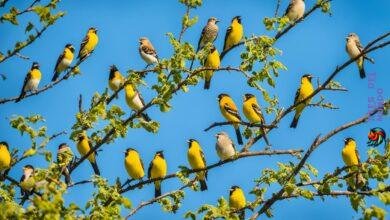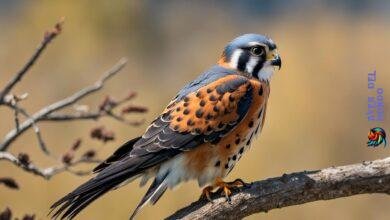The California condor (Gymnogyps californianus) is a New World vulture
The California condor, North America’s largest land bird, is a symbol of hope. These birds, with a vast wingspan over nine feet, were once near extinction. In 1982, only 22 condors were left. Thanks to conservation efforts, their numbers grew to 446 by 2016.
These great birds have faced loss of habitat and pollution. But they have fought hard to survive. Biologists and environmentalists are working to remove the obstacles that threaten these sky icons. They aim to bring them safely back to their native lands.

The California condor’s battle for survival is a powerful story. It shows the danger endangered species face. Yet, it proves humans can help save even the most at-risk animals. This bird is special to Native Americans and represents the Pacific states’ diverse wildlife. Its recovery changes how we manage wildlife and save species today.

The Majestic California Condor: An Overview
Let’s explore the life of the Gymnogyps californianus, or the California condor. They are among the largest flying birds on Earth. With a vast wingspan, they soar gracefully across the sky.
NEST PLACEMENT
Cliff Condors nest primarily in natural cavities or caves in cliffs, although they also sometimes use trees, such as the coast redwood and, historically, the giant sequoia. (As the wild population grows, there is a chance they will return to the redwood forests in the Sierra Nevada.) Condors have multiple nesting sites and can change sites between years. Females make the final decision on which location to use for the nest.
NEST DESCRIPTION
Condors lay their eggs directly on the dirt floor of a cliff or cave, or build loose piles of debris with whatever is available at the nest site, such as gravel, leaves, bark, and bones. Nests have loose boundaries and are typically about 3 feet wide and up to 8 inches deep.
NESTING FACTS
| Egg Length: | 3.6-4.7 in (9.2-12 cm) |
| Egg Width: | 2.4-2.7 in (6.2-6.8 cm) |
| Incubation Period: | 53-60 days |
| Nestling Period: | 163-180 days |
| Egg Description: | Pale blue-green bleaching to white or creamy. |
| Condition at Hatching: | Helpless, covered in white down with eyes open. |
Description and Significance
The California condor is a vital part of the North American ecosystem. These majestic creatures help the environment by eating dead animals. This stops the spread of diseases. In the air, their beauty and power remind us of the wild Pacific coast.
Historical Range and Habitat
The California condor once lived across North America. The historical range spanned from the Pacific’s rocky shores to the wooded east. They adapt to many environments, including coasts, grasslands, and mountains. This allowed them to thrive far from human activity.
These birds now mostly live along the Pacific coast. This change highlights the area’s critical role in their survival. By learning about the condor’s past and importance, we understand why we must protect these birds and their homes. The California condor’s wide range and significance as a predator make it a key symbol of conservation and hope.
Decline of the California Condor

The sad story of the California condor shows how human actions have hurt biodiversity in North America. These impressive birds used to soar in the skies in large numbers. But, human settlement and activities have greatly reduced their population. Now, strong laws are needed to save them from disappearing.
Impact of Settlement in the West
The move by Europeans to the West spelled trouble for the California condor. Cities and towns took over the areas where these birds lived. Most settlers did not realize condors were important to nature. They saw them as pests or prizes instead.
This led to the loss of habitats, taking of eggs, and hunting. These actions caused a big decrease in the number of condors.
Endangered Designation and Protective Legislation
The grave danger to the condors led to protective laws. People who cared about conservation highlighted their plight. This helped classify them as endangered and started protective steps. However, even with these actions, issues like lead poisoning and pollution slowed their comeback.
| Year | Population | Legislation | Key Threats |
|---|---|---|---|
| 1900s | Widespread, numbers unknown | Minimal | Hunting, habitat loss |
| 1950s | Sharp decline | Limited protections | Poaching, lead poisoning |
| 1987 | 22 in the wild | Endangered Species Act enforced | Lead toxicity, environmental contaminants |
| 21st Century | Gradual increase | Continued legislation and conservation efforts | Human-induced factors |
This timeline highlights not just the fall of the California condor, but also the ongoing fight to save them. The battle against biodiversity loss shows our duty to nature. It proves that with dedicated and scientific efforts, we can make a difference.
Understanding the California Condor’s Diet and Foraging Behavior

The diet of California condor relies mainly on scavenging. They are key North American scavengers, vital for keeping the environment clean by eating carrion. The foraging behavior of these birds is unique and complex. They fly over large areas to find their food. With their excellent gliding, they use minimal energy while soaring on warm air currents.
They can spot meals from great distances, showing how balanced the ecosystem is. These big birds eat dead animals, keeping other species safe. California condors often eat large mammals. This shows they can adapt to find food in different places.
This perfect match of diet and behavior highlights why California condors are vital to North American wildlife. As scavengers, they play a critical role. They remove dead animals, which helps prevent diseases. This makes nature healthier and more balanced.
Conservation Efforts: From Brink of Extinction to Recovery

The California condor’s comeback is a clear sign of successful conservation work. Organizations and agencies have worked hard to save them. They focused on breeding programs and fighting lead poisoning, which harmed the condors.
The Role of Captive Breeding Programs
Captive breeding is key to saving the California condor. Zoos in California and other places help these birds a lot. They offer a safe place for condors and help them have chicks. Then, they slowly return them to the wild.
The Introduction of Legislation to Combat Lead Poisoning
Fighting lead poisoning is vital for condor conservation. Laws now require non-lead bullets in condor habitats. This move lowers the lead risk to these birds, helping them reclaim their natural spaces.
All these tireless conservation steps lead to a brighter future. We can now hope for the California condor to live freely, a dream that was almost lost.
Challenges in California Condor Conservation

The California condor is fighting for survival due to conservation challenges. Issues include environmental contaminants and habitat disturbance. There’s a big need for wildlife protection plans.
Threat of Poisoning from Environmental Contaminants
Condors face a big threat from environmental contaminants. Lead from old ammo is dangerous to them. Pesticides like DDT also harm their ability to reproduce, making recovery hard.
The Ongoing Battle Against Habitat Disturbance
Their homes are also at risk due to human activity. Things like city growth and logging make habitat disturbance worse. This leads to less food and places for them to live.
| Conservation Issue | Impact on California Condor | Current Measures |
|---|---|---|
| Lead Contamination | Lead poisoning from ingested ammunition | Legislation for non-lead ammunition in condor habitats |
| DDT and other Pesticides | Impaired reproduction and eggshell thinning | Continued efforts to ban harmful pesticides |
| Habitat Loss | Decreased breeding success and food scarcity | Protected areas designation and land management plans |
California Condor Recovery Program: A Collaborative Success

The California Condor Recovery Program shines as a hope for endangered species recovery. It’s a combined effort showing that when we work together, we can save species on the edge of disappearing. Led by the U.S. Fish and Wildlife Service, it proves working together helps our planet’s biodiversity.
Many partners have come together with one goal: bring back the California condor. This effort is careful, focused, and checks its progress to keep condors flying for years to come. It’s not just about more birds but having them thrive across their old homes.
The California Condor Recovery Program is driven by love for nature. It has seen real wins, like condors born in the wild. These victories come from many groups joining forces, each adding its special skills.
Every success in the California Condor Recovery Program is a celebration. These moments show the power of teamwork in collaborative conservation.
This multi-entity effort aims high: a world where condors fly free and safe. Even against big odds, coming together shows we can overcome and lead global conservation.
«California condor»: Detailed Profile of America’s Largest Land Bird

We embark on a journey to explore the California condor profile. This grand bird of prey showcases resilience and has evolved over millions of years. They reign over vast landscapes, symbolizing strength and adaptation.
Physical Traits and Lifespan
The California condor has a wingspan up to 9.8 feet, making it North America’s largest bird of prey. Its silhouette against the Californian sky is breathtaking. These birds have a strong build, ideal for long flights. Their featherless head and neck change color to signal readiness for mating. Impressively, they can live over 60 years in the wild.
Nesting Patterns and Reproduction
Choosing a nest, California condors prefer giant sequoia cavities or hidden cliff spots. This ensures safety and privacy. They lay one egg every two years, focusing on raising their young well. This slow breeding helps their population to grow steadily but surely.
Their careful nesting and breeding strategies show their deep connection with nature. Despite challenges, they strive to thrive, taking advantage of what the environment offers.
| Aspect | Description |
|---|---|
| Main Habitat | High elevation cliffs, giant sequoia tree cavities |
| Reproductive Cycle | One egg every two years, with intensive parental care |
| Conservation Status | Critical; ongoing efforts for population recovery |
| Lifespan in Wild | Up to 60 years, with a slow maturation process |
The lifecycle of the California condor reveals the bird’s magnificence. From its secluded beginnings in giant sequoias to dominating the skies for decades, it’s a testament to America’s iconic bird of prey.
Current Status: Numbers and Distribution of the California Condor
The California condor, a key symbol in North American wildlife conservation, now sees a glimmer of hope. Over 460 individuals have been counted as of 2017. This includes both wild and captive birds. Thanks to captive breeding success and smart reintroduction efforts, their numbers have grown. This growth shows we’re moving past the times of their uncertain fate. Now, with steady effort, these majestic birds may flourish in old habitats once more.
Wild Versus Captive Populations
Captive populations are vital for keeping the species safe. They ensure genetic diversity and protect against major losses in the wild. These groups are the backbone of recovery and reintroduction plans. Now, we see California condors flying in places like Big Sur and the Grand Canyon. This shows their numbers are climbing in the wild. It’s a sign that their struggle for survival is paying off, marking a win in conservation.
Expansion into Historical Territories
The California condor is slowly moving back into historical territories. Successful reintroductions have brought them back to native areas. This is proof of their endurance and the program’s success. Now, more condors are flying freely without human aid. Conservationists aim for a future where these sights are common. It’s a dream they’re working hard to achieve.
Interesting facts about condors in California
- At the end of the Pleistocene, about 40,000 years ago, California condors were found throughout North America. At that time, the giant mammals roamed the continent, providing the condors with a reliable supply of food. When Lewis and Clark explored the Pacific Northwest in 1805, they found condors there. Until the 1930s they occurred in the mountains of Baja California.
- One of the reasons the California condor’s recovery has been slow is its extremely slow reproduction rate. Female condors lay only one egg per nesting attempt and do not always nest every year. The young depend on their parents for more than 12 months, and take between 6 and 8 years to reach maturity.
- Condors fly slowly and steadily. They average around 30 mph in flight and can reach up to over 40 mph. They take about 16 seconds to complete a circle in high flight. By comparison, bald eagles and golden eagles typically circle in 12 to 14 seconds, and red-tailed hawks do so in about 8 to 10 seconds.
- On carcasses, California condors dominate other scavengers. The exception is when a golden eagle is present. Although the condor weighs about twice as much as the eagle, the eagle’s upper talons command respect.
- Condors can survive 1 to 2 weeks without food. When they find a carcass, they eat their fill and store up to 3 pounds of meat in their crop (a part of the esophagus) before leaving.
- California condors once foraged on coastal islands, visiting colonies of mammals and seabirds to eat carrion, eggs, and possibly live prey, such as chicks.
- In cold weather, condors raise their neck feathers to keep warm. When it’s hot, condors (and other vultures) urinate on one leg. As the waste evaporates, it cools the blood circulating through the leg, lowering the temperature of the entire body. Condors bathe frequently and this helps prevent debris buildup on their paws.
- Adult condors sometimes temporarily restrain an overzealous chick by placing a foot on its neck and pinning it to the ground. This forceful approach is also a common way for an adult to remove a chick’s beak from its throat at the end of a feeding.
- It can take months for hatchlings to perfect flight and landing. «Must» landings have been observed in young people four months after their first flight.
- What’s in a name? The name “condor” comes from cuntur, which originated from the Inca name for the Andean condor. Its scientific name, Gymnogyps californianus, comes from the Greek words gymnos, meaning naked, and referring to the head, and gyps, meaning vulture; californianus is Latin and refers to the birds’ range.
- California condors can probably live to be 50 years old or more.




